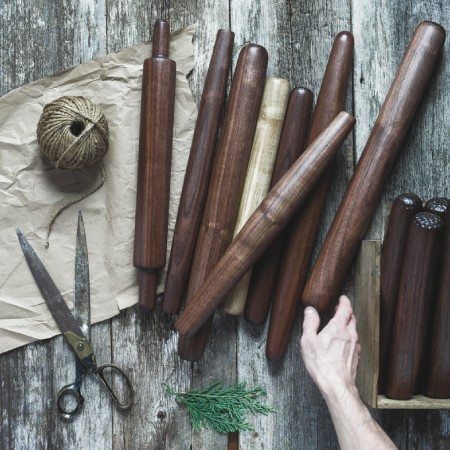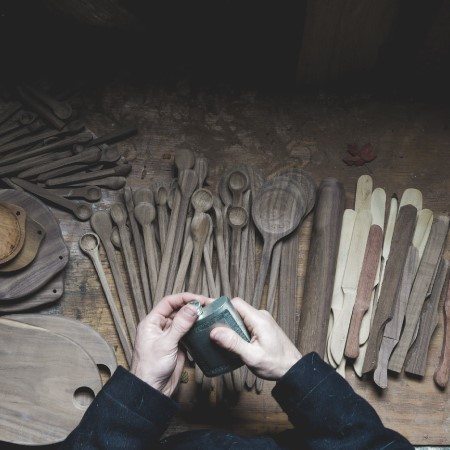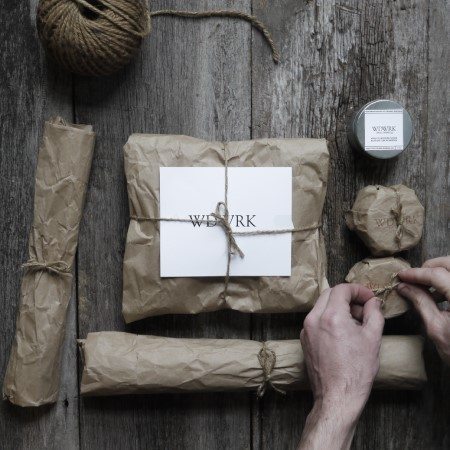Carving a Modern Creative
Originally from the outskirts of Sacramento, Rob Laliberte currently lives and works out of his multi-purpose shop in the Fourth and Gill area of North Knoxville. Before I sat down with Rob, I knew him as a woodworker whose booth at the Farmer’s Market I passed on occasion, which was covered in beautiful hand-carved wood pieces and utensils decorated with alluring patterns. Getting the chance to dive a bit deeper, I learned that he works with more than just a chisel; Rob spoke with me about finding inspiration in Knoxville and expanding his brand of design and community.
BLANK: So I have the idea that you’re a pretty well-rounded guy when it comes to being creative and the outlets through which you’re able to showcase that talent. Tell me about some of the creative endeavors you’ve spent time on over the last few years.
ROB: For the most part, I’ve been working on illustration, woodworking, and graphic design. Before those things took off, I dabbled in several different creative outlets including video game design, playing and recording music, touring with a local band for a while – it was an interesting time. When I was in it, I pursued all of those things wholeheartedly, but I suppose graphic design has been the underlying focus the entire time, as I’ve been doing it since I was about twelve. It’s always fascinated me and is now starting to become something more prominent.
BLANK: Sounds like some pretty diverse circumstances led you to where you are now with your design work. What about the other end of the spectrum, how did you get started creating with your hands and doing woodwork?
ROB: My earliest job was at the age of sixteen – I was refinishing furniture. That was definitely my entry into woodworking, and I was able to do it for about three years. Everything I learned during my time there still applies to what I’m doing today. Anything beyond that is basically self-taught.
BLANK: You probably could’ve continued to perfect your woodworking and dropped the other hobbies if you wanted to. But you didn’t – you kept up with everything. With so many things to be passionate about, how did you decide which to pursue?
ROB: Essentially, I have spent my life chasing the things I love and learning what I can about them. Every time I do that, I jump all the way in and do everything I can to do those things to the best of my ability. I try to work hard enough at a single task as if it was my main interest. I tend to enjoy education and learning, so when I find something I like I just throw myself at it. I find a way to make it work in congruence with everything else I do.
Rob’s buffalo tenders and my fried green tomatoes arrived. As we chowed down on our fried Barley’s cuisine, we continued to discuss the different in opinion of the term “artist,” and whether or not he should consider himself one.
BLANK: I’ve noticed you continually refer to yourself as a designer but not as an artist or craftsman. Do you see yourself as one or the other, neither, both?
ROB: I see myself as less of an artist. I honestly don’t know if it’s anyone’s place to say that about themselves, because I believe it is for other people to call. I’ll say designer or illustrator, because they’re very different terms, but neither of those I would call art. Design always has a goal, and art is relatable, human, and social – it’s supposed to create a feeling. Art is for enlightenment and enjoyment; design always serves a purpose. It has a goal in finding a solution to a problem.
BLANK: You seem to have a clear idea of the values you want to convey through your designs, but I also know it didn’t come to you over-night. How has your personal creative aesthetic evolved over the years?
ROB: In regard to my woodworking, it has completely exploded over the last year. It has gone from nothing, to being an idea, to being represented in a ton of different places. I ship my products all over the world; it’s remarkable. I’ve learned that you really have to get your hands dirty if you want to succeed in this industry because it is so competitive, but the end result is also very worth the mud you trudge through to get there.
BLANK: So, you’ve told me that both your wood shop and your design set-up are at your house. Where do you go to seek inspiration when you’ve worked too hard and need a break?
ROB: Honestly, I’m completely inspired by my community via social media and online. Largely, on Instagram. The body of work that these people put out is entirely motivating, even to simply work beside someone through social media. I’m easily encouraged by my community there. As far as finding inspiration outside of that, I go through seasons where I take a lot of walks – it’s a really big component for me to get in my element.
As long as I’m taking enough time out for myself, I have no problem feeling recharged. Breaks are important and something I take for granted a lot is the ability to switch between mediums – I can take a break from one and see a totally different perspective on the other; they make each other stronger.
BLANK: Describe your creative process in 10 words or less.
ROB: Everything is a process of changing imagination into tangible.
BLANK: Wrapping up, let’s talk about purpose and intent. What do you want to understand yourself and demonstrate to others through your work?
ROB: Across a range of platforms and constraints, my work always seeks to understand the reason for something to exist. I create to express and share my thoughts on what I think it means to live authentically. Not creating work that exploits, damages, or seeks to purely turn profit. I do work that is meaningful to me, sheds light to the larger creative community making special interest to not be part of the noise of this world.
If you’d like to collaborate on a creative idea with Rob or see more of his woodwork, hit him up via his website, www.roblaliberte.com, or Instagram @RobLaliberte.









